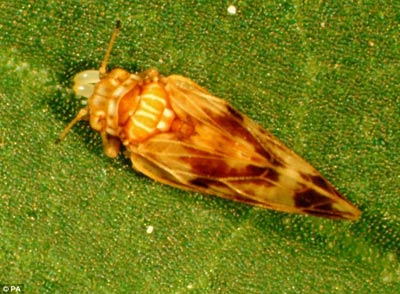Find mushrooms and insects to kill harmful plants
The abundance of little trees on England will end thanks to a Japanese insect and fungus.
Japanese Chit is an invasive plant with a height of 3-4 meters, beautiful leaves and white inflorescences. They are often grown to beautify houses and farms. This species grows very fast (can reach a height of 4 meters in 4 months) and has a tremendous spread rate.
Since the 1940s of the 19th century, some Welsh people brought a bit of chit to plant as an ornamental plant, but soon the plant expanded throughout the United Kingdom. Extremely fast, but very difficult to destroy, they occupy land and destroy other crops, resulting in reduced agricultural productivity. In addition, little chit also weakens construction works, walls and dykes against floods.
By the time the British realized that a bit of chit was a danger, the situation was too late. Removing a little bit of chit is not only costly but also time consuming, because a little bit of root remains in the soil will turn into a big tree for several months .

Aphalara itadori plastic lice.(Photo: Dailymail)
Although a bit of chit in England comes from Japan, but in the land of cherry blossoms, they have no chance of expanding because there are so many enemies.
In 2000, CABI - a nonprofit agricultural research organization - sent experts to England to learn the natural enemies of a bit of chit.
"It turns out that there are 186 species of insects and about 40 species of mushrooms like to eat a little bit," said Dick Shaw, head of the expert team.
Dick and his colleagues experimented to find an insect that only likes to eat a little bit of chit but does not destroy other crops in the UK. After countless experiments, the savior was identified. It is a louse of Aphalara itadori and a fungus that causes leaf spots in the Mycosphaerella family .
CABI has submitted the project to remove the little bit of lice with lice and the leaves that cause leaf spots. If approved, this will be the first time that biological control (using this species to control another species) is used in Europe in weed war.

Fungi cause leaf spots.(Photo: Dailymail)
Some argue that the use of biological control can cause unpredictable consequences.
In the 30s of the 20th century, Australian sugar producers sought to control the development of sugarcane beetles by feeding poisonous sugarcane frogs from South America. Amphibians kill not only beetles but also other beneficial insects, so that their numbers increase dramatically. Today, they become one of the harmful species to destroy.
In the UK, some farms seeking to kill aphids with ladybirds also have disastrous consequences, as their appearance paves the way for multicolored ladybirds - a poisonous and aggressive insect. If it was discovered in 2004 that the presence of multicolored ladybirds, they have been present throughout the country for about a billion. Their expansion pushed many native plants and animals into danger.
CABI scientists claim to loosen tree sap and fungi causing leaf spots that cannot become British fears. Because they only eat a little bit of chit, their numbers will decrease when this plant is destroyed.

Japanese little tree (Photo: Coldclimategardening)
- Insects can find infected plants
- Home to kill insects
- Bt cotton helps control pests
- Detecting 16 harmful insects in coffee plants
- Kill plants with insects
- Kill insects with 'tips'
- Find four natural substances that kill insects
- Detecting night glowing mushrooms in Brazil
- Shiitake mushrooms help improve immune function in humans
- Insecticides can kill 3 generations of cockroaches
- Harmful when storing and using lingzhi wrongly
- Top 10 most rare mushrooms in Vietnam
 Why do potatoes have eyes?
Why do potatoes have eyes? 'Tragedy' the world's largest carnivorous life: Death becomes ... public toilet
'Tragedy' the world's largest carnivorous life: Death becomes ... public toilet Tomatoes were once considered 'poisonous' for 200 years
Tomatoes were once considered 'poisonous' for 200 years Detecting microscopic parasites on human face
Detecting microscopic parasites on human face